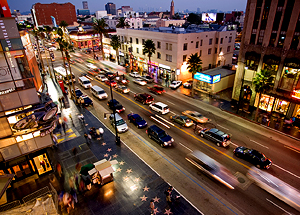RECOMMENDED
Hershey Felder, the award-winning creator of George Gershwin Alone, Monsieur Chopin, and Beethoven, As I Knew Him, now returns with Maestro: The Art Of Leonard Bernstein.
Like its predecessors, Maestro allows the multitalented Felder to inhabit the skin of a famous musical figure, speak with his voice, and perform his music on a Steinway grand. Director Joel Zwick is back too to helm Felder’s latest project, and if Leonard Bernstein lacks the mass appeal of Gershwin, Chopin, and Beethoven, his life nonetheless makes for an entertaining and elucidating journey—particularly for those over the age of fifty. While younger audience members may ask themselves, “Who the heck was Leonard Bernstein?”, those old enough to recall his 1958-1973 Young People’s Concerts or his many other television appearances will likely welcome the chance to spend a hundred or so minutes with one of the greatest symphony orchestra conductors of the 20th Century.
Maestro in fact begins with a clip from one of those old black-and-white Young People’s Concerts, with Bernstein himself explaining and demonstrating to the kids of America how a conductor’s interpretation of a composer’s tempo and mood marking can affect an orchestra’s performance. Felder then takes center stage in a gray Bernstein wig (the action is said to take place on Sunday, October 14, 1990, in Bernstein’s last minutes—when the conductor was seventy-one), going on to explain the genesis of a perfect song, in this case, “Somewhere,” from West Side Story, arguably Bernstein’s most famous work as a composer.
Felder/Bernstein then flashes back in time to tell the conductor’s life story, beginning with his upbringing in the Massachusetts home of immigrant Ukrainian Jewish parents. Though young Leonard’s father initially opposed his son’s interest in music, he later gave in, buying Leonard his first baby grand and allowing him to pursue his music studies at Harvard.
It doesn’t take long for Maestro to reveal Bernstein’s attraction to other men, and his love affairs with older mentors (Dimitri Mitropoulos was about twice Leonard’s age when the two became lovers). Still, Maestro (with book by Felder) maintains that Bernstein’s wife Felicia was his soul mate, the love of his life, and that leaving her post-Stonewall to follow his gay heart (and libido) was his greatest regret—a statement that may rankle some. (West Side Story book writer Arthur Laurents insists that Bernstein was “a gay man who got married. He wasn’t conflicted about it at all. He was just gay,” and one can’t help but wonder what a Laurents-penned Maestro might be like.)
Though Bernstein was (and remains to this day) one of the greats of American music, his frustration with his inability to establish himself as a great composer (as well as Felder-as-Bernstein’s expressions of guilt for having left Felicia), make Maestro a bit of a downer. It would be even more of one had it included Bernstein’s lifelong heavy smoking and the emphysema he was diagnosed with in his mid twenties. (Interestingly, the real Bernstein seemed not at all guilty about his many vices, commenting cockily in his 60s that “Well, I beat the rap. I smoke. I drink. I stay up all night. I screw around. I’m over committed on all fronts.” He didn’t make it to seventy-two.)
Maestro allows Felder to perform from the Bernstein oeuvre (mostly songs from West Side Story) as well as works by Beethoven, Rimsky-Korsakov, and Grieg (among others). He also vocalizes, in his own voice rather than Bernstein’s far raspier one, the highest notes of “Somewhere” and other West Side Story classics proving considerably less flattering to Felder’s pipes than the many Gershwin tunes he performed in George Gershwin Alone.
As always, François-Pierre Couture has created a gorgeous blend of scenic, lighting, and projection design, the latter particularly effective as it allows us to see the real Bernstein and the people who most influenced his life. (Black-and-whites of a very young Leonard and aged mentor Serge Koussevitzky side by side in matching white tuxes must surely have set tongues wagging in the 1940s.) Andrew Wilder shares credit for the illuminating projection design. Erik Carstensen’s sound design is an excellent one as well, allowing Felder to perform live with a pre-recorded symphony orchestra.
GiGi Garcia is production stage manager, Brett Taylor production associate, Margaret Hartman lighting director/assisting lighting designer, Jeffrey Kallberg, Ph.D production consultant, and Matt Marsden lighting director/technical director.
Ultimately, though not without its shortcomings, Maestro: The Art Of Leonard Bernstein offers audiences, particularly those born before the Kennedy presidency, an enlightening glimpse at one of the major musical figures of the last century. If only he’d been able to create that classical masterpiece he so longed to leave behind …
Geffen Playhouse, 10886 Le Conte Ave., Westwood.
www.geffenplayhouse.com
–Steven Stanley
November 11, 2010
Photos: Michael Lamont





 Since 2007, Steven Stanley's StageSceneLA.com has spotlighted the best in Southern California theater via reviews, interviews, and its annual StageSceneLA Scenies.
Since 2007, Steven Stanley's StageSceneLA.com has spotlighted the best in Southern California theater via reviews, interviews, and its annual StageSceneLA Scenies.







 COPYRIGHT 2025 STEVEN STANLEY :: DESIGN BY
COPYRIGHT 2025 STEVEN STANLEY :: DESIGN BY